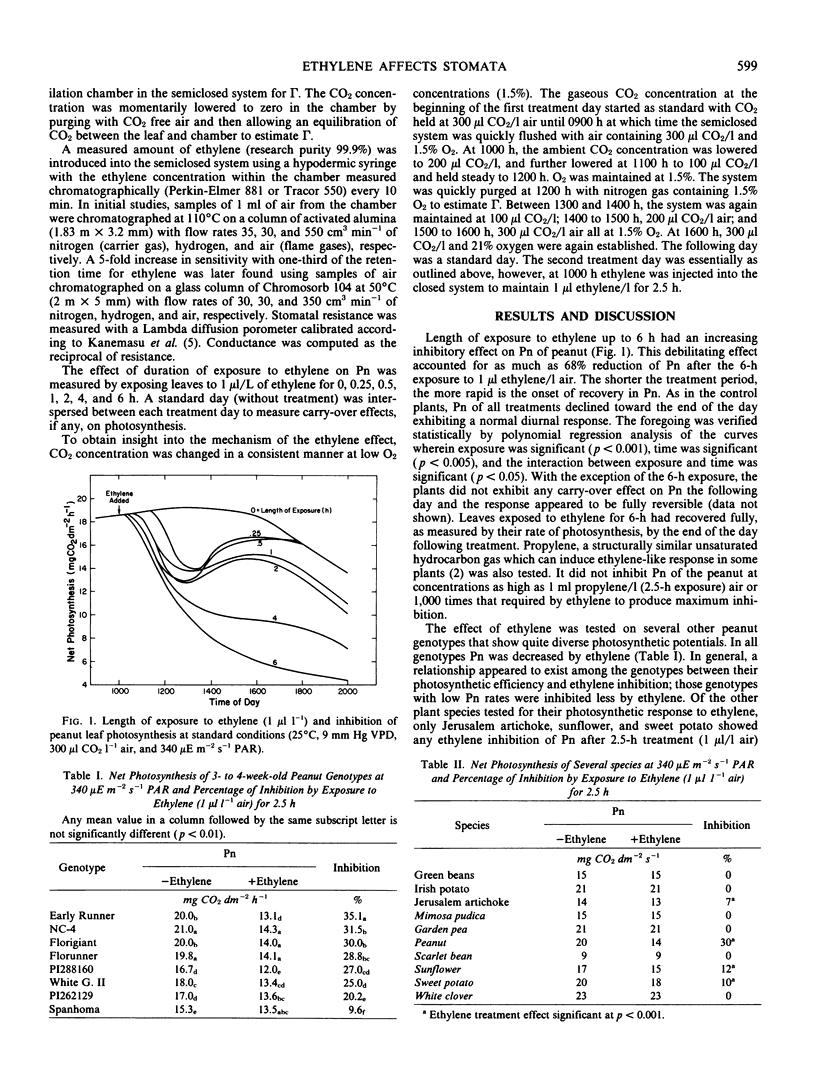Abstract
Ethylene at hormonally significant levels inhibited net photosynthesis of the cultivated peanut (Arachis hypogaea L.) as measured by gas analysis. Upon the removal of ethylene, the inhibition was naturally overcome at the concentration-exposure duration combinations tested. Increased length of exposure of 1 microliter of ethylene per liter of air up to 6 hours increased the degree of net photosynthesis inhibition (68% reduction after 6-hour exposure). Significantly greater inhibition of photosynthesis by ethylene was detected on peanut genotypes having higher photosynthetic efficiency. In contrast to peanut, hormonal concentrations of ethylene only moderately inhibited sweet potato, Jerusalem artichoke, and sunflower photosynthesis and was without effect on beans, peas, Irish potato, Mimosa pudica, and white clover. No inhibition could be found by ethylene on ribulose 1,5-biphosphate carboxylase activity in vitro. Photosynthesis was lowered at all CO2 concentrations below ambient at an O2 concentration of 1.5%, indicating that the action of ethylene was not affected by low O2; concomitantly, an increase in the CO2 compensation point occurred. Diffusion resistance measurements of leaf water vapor loss made on ethylene-treated peanut leaves showed a measurable decrease in leaf conductance which correlated with net photosynthesis decrease. Ethylene influenced the conductance of abaxial stomata more so than adaxial.
Full text
PDF



Selected References
These references are in PubMed. This may not be the complete list of references from this article.
- Burg S. P., Burg E. A. Molecular requirements for the biological activity of ethylene. Plant Physiol. 1967 Jan;42(1):144–152. doi: 10.1104/pp.42.1.144. [DOI] [PMC free article] [PubMed] [Google Scholar]
- Hanson A. D., Kende H. Ethylene-enhanced Ion and Sucrose Efflux in Morning Glory Flower Tissue. Plant Physiol. 1975 Apr;55(4):663–669. doi: 10.1104/pp.55.4.663. [DOI] [PMC free article] [PubMed] [Google Scholar]
- Kanemasu E. T., Thurtell G. W., Tanner C. B. Design calibration and field use of a stomatal diffusion porometer. Plant Physiol. 1969 Jun;44(6):881–885. doi: 10.1104/pp.44.6.881. [DOI] [PMC free article] [PubMed] [Google Scholar]
- Pallaghy C. K., Raschke K. No stomatal response to ethylene. Plant Physiol. 1972 Feb;49(2):275–276. doi: 10.1104/pp.49.2.275. [DOI] [PMC free article] [PubMed] [Google Scholar]
- Pallas J. E. An apparent anomaly in peanut leaf conductance. Plant Physiol. 1980 May;65(5):848–851. doi: 10.1104/pp.65.5.848. [DOI] [PMC free article] [PubMed] [Google Scholar]
- Pallas J. E., Jr Transpiration and Stomatal Opening with Changes in Carbon Dioxide Content of the Air. Science. 1965 Jan 8;147(3654):171–173. doi: 10.1126/science.147.3654.171. [DOI] [PubMed] [Google Scholar]


